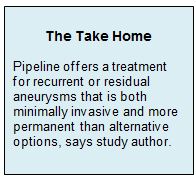Key Points:
- Study examines use of Pipeline for residual/recurrent aneurysms following clipping or coiling
- Almost all aneurysms completely or nearly completely occluded at 6 and 12 months

Senior author Ajit S. Puri, MD, of the University of Massachusetts (Worcester, MA), and colleagues are keen to learn whether other centers are experiencing similar success.
For the study, they retrospectively reviewed their database to identify all 24 patients treated with a Pipeline device (Medtronic) for recurrent or residual intracrianal aneurysms. Eighteen had previously been treated with coiling for 11 ruptured and 7 unruptured aneurysms and 6 had undergone with clipping for 3 ruptured and 3 unruptured aneurysms. Most aneurysms (n = 21) occurred in the anterior circulation.
These repairs typically represented an off-label use of Pipeline, Dr. Puri explained in an interview with NVX, since the aneurysms did not always match current US Food and Drug Adminsitration-stipulated size and location parameters for this device.
There were no changes in preprocedure mRS score at discharge or at any scheduled follow-up. Almost all patients assessed at 6 and 12 months had complete or near complete occlusion of their aneurysm on follow-up. Only 1 patient (with an unruptured aneursym) had a partial occlusion (table 1).
Table 1. Angiographic and Neurologic Follow-Up
|
|
6 Months (n = 18) |
12 Months (n= 15) |
|
Median mRS |
0 |
0 |
|
Complete Aneurysmal Occlusion |
12 |
10 |
|
Near Complete Occlusion |
5 |
4 |
|
Partial Occlusion |
1 |
1 |
|
Mild-Moderate Intimal Hyperplasia |
3 |
2 |
One case of moderate intimal hyperplasia was observed at 6 months, but this decreased to mild at the 12-month follow-up. The Pipeline device appeared to be similarly effective in both ruptured and unruptured aneurysms.
A Potential New Standard of Care
Dr. Puri explained that the study findings reflect what they have been seeing in clinical practice, with complete or near-complete occlusion rates consistently surpassing 90% at 6 months. What’s surprising is that no one else has yet suggested Pipeline for this indication, he said. “We felt that it was a very elegant and novel method.”
Before Pipeline, recurrent and residual aneurysms would have been treated with yet more clipping and coiling. In addition to being a minimally invasive option, Pipeline repair is “more permanent,” said Dr. Puri. “It has been shown in follow-up of the PUFS trial that aneurysms once treated by this device are never coming back. And that’s what we see in our practice. We have never seen an aneurysm treated with this device coming back.”
Dr. Puri is eager to see results from other centers using the Pipeline in a similar manner. If larger, multicenter studies with longer follow-up demonstrate comparable outcomes, it would provide the evidence needed to make this approach part of standard practice.
Source:
Kühn AL, de Macedo Rodrigues K, Lozano JD, et al. Use of the Pipeline embolization device for recurrent and residual cerebral aneurysms: a safety and efficacy analysis with short-term follow-up. J NeuroInterv Surg. 2016;Epub ahead of print.
Disclosures:
Dr. Puri reports being a consultant for Codman Neurovascular, Stryker Neurovascular, and Covidien, as well as receiving a research grant from Stryker Neurovascular and Covidien and being a speaker for the Miami Cardiovascular Institute. He has also worked as a proctor for both Medtronic and Stryker devices.